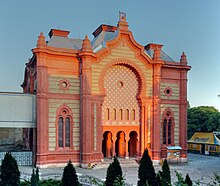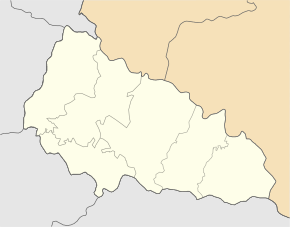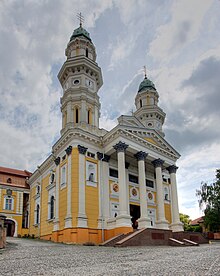Uzhhorod
| Uzhhorod | ||
| Uzhgorod | ||

|
|
|
| Basic data | ||
|---|---|---|
| Oblast : | Zakarpattia Oblast | |
| Rajon : | District-free city | |
| Height : | 137 m | |
| Area : | 31.56 km² | |
| Residents : | 115,568 (2004) | |
| Population density : | 3,662 inhabitants per km² | |
| Postcodes : | 88000 | |
| Area code : | +380 312 | |
| Geographic location : | 48 ° 37 ' N , 22 ° 18' E | |
| KOATUU : | 2110100000 | |
| Administrative structure : | 1 city | |
| Mayor : | Viktor Pohorelov (2010) | |
| Address: | пл. Поштова 3 88000 м. Uzhgorod |
|
| Website : | http://www.umr.uzhgorod.ua/ | |
| Statistical information | ||
|
|
||
Uzhgorod ( Ukrainian Ужгород , pronunciation: [uʒɦɔrɔd] ; Russian Ужгород Uzhgorod , Hungarian Ungvár , German Uzhgorod , Rusyn Уґоград Ugohrad , Czech and Slovak Užhorod ) is the capital of Zakarpattia Oblast in the Ukraine and seat of the administrative center for the Uzhhorod Raion . It is located in the triangle between Hungary , Slovakia and Ukraine, right on the Slovakian border . It has 117,300 inhabitants ( 2001 census ) and is the seat of a Greek Catholic diocese (head of the Ruthenian Church).



City name
The name of the city comes from its location on the river Ush (Ukrainian Уж ), but is associated with the Ukrainian word for snake (usch) in folk etymology . Due to the multiplicity of ethnic groups who lived through the centuries in Uzhhorod and live, there are different linguistic labels for Uzhhorod: Hungarian Ungvár , Ukrainian Ужгород Uzhhorod , Ruthenian Ужгородъ Uzhhorod, Russian Ужгород Uzhgorod , Slovak and Czech Užhorod , German Ungwar or Ungstadt , Yiddish אונגוואַר Hungary .
City structure
The city is divided into 17 parts:
- Bosdosch
- Bolotyna (swamp)
- Werbnyk (pasture area)
- Talahow
- Horjany (Ukrainian Горяни, Hungarian Gerény , incorporated in 1970)
- Domanynzi (Ukrainian Доманинці, Hungarian Alsódomonya )
- Drawzi (Ukrainian Дравці, Hungarian Ungdaróc , incorporated in 1940)
- Kalwary
- Mynaj (Ukrainian Минай )
- Castle District
- Promyslowyj (industrial zone)
- Radwanka (Ukrainian Радванка , Hungarian Radvánc , incorporated in 1940)
- Stanzijnyj (Bahnhofsviertel)
- Storoschnyzja (Ukrainian Сторожниця )
- Zeholnja
- Tscherwenyzja (Ukrainian Червениця )
- Shakta
history
Uzhhorod and Zakarpattia have belonged to numerous ruled areas over the last centuries and their inhabitants have been exposed to many border shifts. Based on archaeological finds, the first settlements in today's urban area are suspected to date back to the early Paleolithic (100,000 years BC), and evidence of settlement is also available from the Bronze and Iron Ages .
After the Great Migration Period , Slavs moved into the area . According to archaeological finds, the Uzhhorod fortress was built at the turn of the 8th and 9th centuries and then became an important fortress in Greater Moravia . Written chronicles document the existence of the castle (site) for the first time in the year 903 (the mention of the year 872 is rather controversial). From the 10th to the 11th centuries, Uzhhorod was the southwestern outpost of the Kievan Rus .
It was conquered by Hungary in the middle of the 11th century . The conquest of the rest of Transcarpathia was then completed by the 13th century. Until 1918/19 the city belonged to the Kingdom of Hungary with changing princes and thus from 1526 to the Austrian monarchy and from 1867 to Austria-Hungary . Within Hungary the city was called Ungvár and was the capital of Ung (Usch) county .
As part of the Trianon peace treaty , Uzhhorod and Carpathian Ukraine fell to the newly founded Czechoslovakia in 1919 . Until 1938, Uzhhorod was now the capital of the autonomous Carpathian Ukraine within Czechoslovakia. With the First Vienna Arbitration on November 2, 1938, Uzhhorod and the southern strip of Carpathian Ukraine became Hungarian again.
Towards the end of the Second World War , on October 27, 1944, Uzhhorod was captured by the Red Army in the Eastern Carpathian operation . In June 1945 the city was ceded by Czechoslovakia to the Soviet Union and in 1946 it became the center of the newly established Transcarpathian Oblast within the Ukrainian Soviet Republic of the USSR. Since August 1991 it has been part of the newly established Ukraine .
population
In 2001 there were 117 317 inhabitants in Uzhgorod. The proportion of the different ethnic groups was:
- Ukrainians and Russians 77.8% (Ruthenians)
- Russians 9.6%
- Hungary 6.9%
- Slovaks 2.5%
- Roma 1.5%
- German 0.3%
Denominations
Most of Uzhhorod's residents belong to two (out of three) major Ukrainian denominations , the Greek Catholic Church and the Orthodox Church . The Hungarian population is predominantly Roman Catholic or belongs to the Reformed Church in Transcarpathia . Baptists are also well represented among Protestants . Since Ukrainian independence , numerous other Christian denominations and movements have established themselves, e. B. Pentecostals , Adventists, and Jehovah's Witnesses . In the Soviet era, a synagogue was converted into a concert hall after the war.
Economy and Infrastructure
There are industrial settlements in the areas of furniture production, machine and electrical appliance construction, chemical industry, food industry, shoe factory. The city has an airport and is a very important road border crossing to Slovakia (and thus also to the EU ). Uzhhorod is home to many schools, technical schools, academies and the Uzhhorod National University, founded in 1946 .
Uzhhorod is also the end point of the 2,750 km long “ Soyuz ” natural gas pipeline from Orenburg , the construction of which was carried out by the Comecon states over several decades . Planning and construction of the approx. 550 km long section of the GDR , the Druzhba route , was, like the sections of the other states, only delegated by the former USSR to the " socialist brother countries " and paid for by later supplying natural gas free of charge.
Connection to the railway network has existed since 1872 through a line from Tschop, which was extended to Lemberg in 1905 (see Lviv – Sambir – Tschop line ). The broad-gauge Uzhhorod – Košice line has also existed since 1966 .
Culture and sights
Architecturally, the historic city center of Uzhhorod is reminiscent of old Austria-Hungary in many ways . A great example of this is the Baroque Exaltation of the Cross Cathedral . In addition, there are Soviet and post-Soviet prefabricated buildings in the administration buildings and in the outskirts and new, private residential buildings that do not seem to be subject to any construction plans. In spring, several streets in the city center are criss-crossed with lush Japanese cherry blossoms ( sakura ), which give off a strong scent, especially at night. All summer long, along the river Usch (Slovak and Ruthenian Uh), the trees of Europe's longest linden avenue, which is a popular promenade for young and old, bloom.
Other sights include the old castle from the 9th century AD and the nearby open-air museum Museum of Folk Architecture and Life in the Transcarpathian Mountains , in which the typical Transcarpathian wooden architecture is presented. For this purpose, original buildings, a church, a school and typical regional farmhouses from the entire oblast have been transported here and rebuilt.
There is an art museum, a museum of Transcarpathian wooden architecture and a local museum.
sons and daughters of the town
- Salomon Ganzfried (1804–1886), Talmudist, Hebrew grammarian
- Samuel Lipschütz (1863–1905), American chess master of Hungarian origin
- Jenő Janovics (1872–1945), Hungarian film pioneer
- Felix Krivin (1928–2016), Russian-Ukrainian-Israeli writer; lived here from 1955 to 1998
- József Szabó (* 1940), Soviet football player and Hungarian-Ukrainian coach
- Volodymyr Akulow (* 1944), Ukrainian theoretical physicist
- Serhij Kwit (* 1965), Ukrainian politician, literary critic and journalist
- Nil Jurij Luschtschak (* 1973), Ruthenian Greek Catholic bishop
- Pawel Runow (* 1976), accordion player
- Vladimir Koman (* 1989), Hungarian football player of Ukrainian descent
- Witalina Kowal (* 1990), women's rights activist
Town twinning
-
Békéscsaba , Hungary since 2001

-
Corvallis , United States since 1992

-
Česká Lípa , Czech Republic since 2000

-
Darmstadt , Germany since 1992

-
Horsens , Denmark since 2002

-
Jarosław , Poland since 2002

-
Kajaani , Finland since 2003

-
Košice , Slovakia since 2003

-
Krosno , Poland since 2008

-
Michalovce , Slovakia since 2001

-
Moscow , Russia since 2003

-
Nyíregyháza , Hungary since 1999

-
Oryol , Russia since 2001

-
Pula , Croatia since 2010

-
Satu Mare , Romania since 2006

-
Sárospatak , Hungary since 2011

See also
- History of Carpathian Ukraine
- History of Slovakia
- History of Czechoslovakia
- History of Ukraine
- History of Hungary
- List of historical counties of Hungary
- SK Rusj Uzhhorod
Web links
Individual evidence
- ↑ Archived copy ( Memento from September 30, 2007 in the Internet Archive )
- ↑ http://www.darmstadt.de/standort/staedtepartektivenen-und-internationales/ushgorod-ukraine/index.htm







